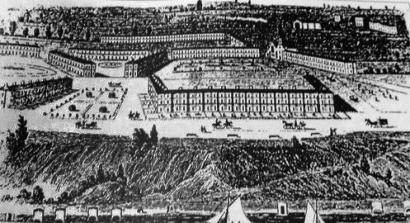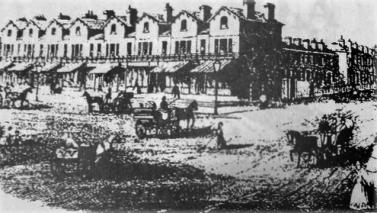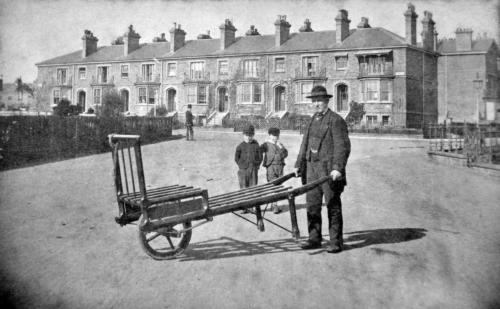The Cliff Town Estate

Southend-on-Sea
In
1853,
Southend
was
described
as
“quiet,
dull
Southend…..
with
its
half
dozen
bathing
machines
and
its
two
dozen
or
so
bathers.”
Nonetheless,
the
potential
for
development
of
this
“quiet
place
for
quiet
people”
did
come
to
the
notice
of
some
well-established
speculators.
In
1854,
the
railway
developers
Messrs
Peto,
Brassey
and
Betts
leased
the
railway
and
completed
the
development
of
the
Tilbury
line
to Southend.
Imagine
these
gentlemen
speculators
Sir
Morgan
Peto
and
Mr
Thomas
Brassey
arriving
from
London
one
day,
having
sampled
their
railway
service
to
Southend
Station
–
now
Southend
Central
–
which
opened
in
1856.
The
gentlemen
walk
out
of
the
station
and
turn
right
into
a
track
called
High
Street
because
it
took
the
high
ground
between
Prittlewell
and
the
hamlet
of
Southend;
there
were
no
bustling shops then, only a few houses and the brewery.
They
might
have
wandered
down
to
the
cliff
top
where
they
would
pause
to
inhale
the
ozone
rising
from
the
mudflats
or
to
enjoy
the
water
if
the
tide
was
in.
If
they
looked
to
their
left,
past
the
bow-fronted
library
building,
they
saw
the
sea
front
jumble
of
the
old
town; below them the old pier. The shrubbery, an enclosed garden, clothed the cliffs below Royal Terrace.
Suppose
that
on
a
whim,
Mr
Brassey
proposed
to
Sir
Morgan
that
they
take
a
turn
along
the
cliff
top
–
to
stretch
their
legs
before
luncheon
at
the
Royal
Hotel.
Perhaps
as
they
approached
the
end
of
the
imposing
terrace,
they
paused
for
a
moment,
to
enjoy
the
sun
on
the
waving
corn
of
Shorefields
with
the
mill
not
far
off
to
the
north.
Here
were
two
seasoned
speculators
maybe
remembering
the
railways
that
they
had
built
in
many
lands.
Peto
received
his
Baronetcy
from
the
service
he
did
the
crown
when
Messrs
Peto,
Brassey and Betts built, gratis, a vital 39 miles of railway from Sebastopol during the Crimean War.
Perhaps
as
he
surveyed
the
farmlands
across
the
cliff
top,
he
saw
another
possibility:
“Hmm,
now
the
railway
is
done
I
should
think
there’s room here for a bit of development. What d’you think Brassey?”
“Indeed, town houses – sea views – just the thing.”
“Yes…and now the railway’s done…”
Perhaps this is how the cornfields became Cliff Town.
On
3rd
October
1859
the
first
stone
of
the
Cliff
Town
Estate
was
laid.
Messrs
Peto,
Brassey
and
Betts
leased
the
land
from
Squire
Scratton
and
together
with
Charles
and
Thomas
Lucas
the
builders,
built
124
town
houses
designed
by
Banks
and
Berry,
Architects
of
Westminster.
A
gasworks
was
built
in
1855
and
waterworks
were
set
up
between
1856
and
1860.
Water
was
pumped
from
the
reservoir directly to tanks in each of the houses on the estate.
The
Cliff
Town
Estate
was
a
shrewd
speculation.
In
the
Railway
Director’s
Report,
1859,
the
builders
promoted
the
Cliff
Town
Estate
in
the
hope
that
“accommodation
which
will
thus
be
afforded
for
residence
at
Southend,
with
proper
facilities
for
speedy
and
convenient
communication
with
the
metropolis
(London),
will
materially
improve
the
traffic
of
the
railway.”
In
the
1851
census,
Prittlewell
which
included
the
hamlet
of
South
End
had
a
population
of
2462. By 1881 the population had risen 220 percent to 7972.
The
Building
News
of
14th
February
1862
described
the
estate:
“The
houses
are
built
of
white
brick,
with
freestone
dressings.
They
are
constructed
in
terraces
laid
out
on
the
summit
of
the
cliff,
connected
diagonally
at
intervals
in
such
a
way
that
those
lying
back
get
sea
views
in
one
direction.
The
houses
are
of
various
classes,
differing
in
size,
in
position
and
in
rental.
The
spaces
between
the
houses
are
turfed
and
planted
out
with
trees
and
shrubs.
Very
few
of
the
houses
are
unoccupied;
and
the
experiment
is
said
to
be
so
successful,
that
it
is
in
contemplation
to
increase
the
number
and
to
add
a
church,
a
hotel
and
a
library and reading room.”
Local
people
and
city
merchants
rented
the
properties
and
one
of
the
first
to
move
in
was
Ellis
Kerry,
the
Stationmaster
at
Southend
Station.
His
neighbours
in
1863
included
Robert
Absalom,
fisherman;
Stanley
Rudd
piano-maker;
Joseph
Clements,
barge
owner
and
several
lodging-house
keepers
including
Miss
Rebecca
Berry
and
Miss
Maria
Bragg.
By
1866
two
‘ladies
schools’
were
established: one at 12 Prittlewell Square run by the Misses Fanny and Jane Manning.
Kelly’s
Gazeteer
for
this
year
mentioned
“the
new
neighbourhood”
and
suggested
that
more
houses
were
contemplated:
“a
great
inducement
being
held
out
to
the
occupants
by
the
Tilbury
and
Southend
Railway
Company
by
the
issue
of
season
tickets
at
the
low
price
of
£10
first
class
and
£7
second
class.
Another
shrewd
move
by
Messrs
Peto
and
Brassey.
Unfortunately
in
this
year
of
1856,
both gentlemen suffered financial losses when a bank they used crashed, so their influence on the Cliff Town development ceased.
By
1856
the
rental
for
houses
in
Cambridge
Terrace
was
£60
per
annum
and
the
ground
rent
£5.
One
feature
of
the
original
development was Nelson Terrace where eight houses were built as shops with accommodation. These were occupied in 1869 by:
No 1 Mr Jas Wheeler Chemist (In 1863 this was a grocers run by Geo Cooch)
No 2 Mr A Harrison, Draper
No 3 Mr F Wakefield, Stationer
No 4 Mr Webster, Butcher
No 5 Mr Ray, Poulterer
No 6 Mr Ulyate, Bootmaker
No 7 Miss Purser, Milliner
No
8
Mr
T
Arnold,
Baker
and
Confectioner,
this
was
a
corner
shop
with
the
bakery in the basement.
The
Railway
Hotel
on
the
corner
opposite
Nelson
Terrace
was
built
before
1872.
The
church
which
is
today
the
Clifftown
United
Reformed
Church
was
built in 1865.
Visitors
to
Southend
now
may
retrace
the
steps
of
Thomas
Brassey
and
Sir
Morgan
on
that
fateful
day
and
see
for
themselves
the
still
elegant
town
houses
of
the
Cliff
Town
Estate.
The
nursery
garden
is
now
the
bowling
green
and
Prittlewell
Square
has
a
pond
with
fountains.
No
longer
surrounded
by
cornfields,
Cliff
Town
is
a
conservative
area
in
a
thoroughly
modern
conurbation.
And
yet,
as
the
Illustrated
London
News
of
1st
June
1861
said,
“the
Cliff
Town
Estate
still
helps
to
supply
a
want
which
the
overworked
middle
classes of London experience.”


Southend Timeline Southend-on-Sea © 2009 - 2024. All Rights Reserved



Barrow Man in Prittlewell Square (From the Terry Herbert Collection)

Southend-on-Sea’s No 1 History Website! Documenting The Town & The Townspeople

Now Incorporating The Sea Of Change Website
Website Info:


Chalkwell ▪ Eastwood ▪ Leigh-on-Sea ▪ Prittlewell ▪ Shoeburyness ▪ Southchurch ▪ Thorpe Bay ▪ Westcliff-on-Sea
SOUTHEND CITY
































































